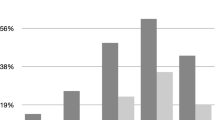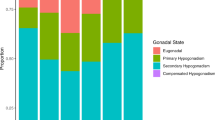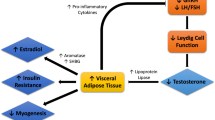Abstract
The Androgen Deficiency in the Aging Male (ADAM) questionnaire is commonly used to screen type 2 diabetes mellitus (T2DM) patients for androgen deficiency symptoms, but the association of low total (TT) and free testosterone (FT) levels with divergent responses to the ADAM questionnaire remains unclear. The aim of this study was to assess the predictive ability of TT and calculated FT (cFT) levels for accurately classifying ADAM status. We recruited 70 patients each with positive (group A) and negative (group B) responses to the ADAM questionnaire and 70 age-matched healthy controls (group C) (mean age, 50.5 years); serum levels of TT were estimated and cFT were estimated using Vermeulen equation. Hypogonadism was defined as the presence of symptoms (positive ADAM score) along with TT level < 300 ng/dL or calculated (cFT) <6.35 ng/dL. BMI was highest in group A (P < 0.05), followed by groups B and C. Group A had longer diabetes durations (P < 0.05) and higher fasting plasma glucose (FPG) and HbA1c levels than group B (P < 0.001). TT levels and cFT were significantly lower in Group A than in the other two groups. In group A, 51 (73%) men had low TT levels (<300 ng/dL) and 48 (69%) had low cFT (<6.35 ng/dL). TT levels < 300 ng/dL had higher sensitivity and specificity (73 and 96%, respectively) than cFT < 6.35 ng/dL (69 and 90%, respectively) for predicting ADAM status. Multivariate-adjusted logistic regression showed that diabetes duration, HbA1c level, and BMI predicted low TT levels, whereas diabetes duration and HbA1c and high-density lipoprotein levels were significant predictors of low cFT. TT levels were a better predictor of ADAM responses than cFT in male T2DM patients. Our results suggest that TT level is better than cFT for diagnosing hypogonadism in T2DM patients when equilibrium dialysis is not feasible.
This is a preview of subscription content, access via your institution
Access options
Subscribe to this journal
Receive 8 print issues and online access
$259.00 per year
only $32.38 per issue
Buy this article
- Purchase on Springer Link
- Instant access to full article PDF
Prices may be subject to local taxes which are calculated during checkout


Similar content being viewed by others
References
Grossmann M. Low testosterone in men with type 2 diabetes: significance andtreatment. J Clin Endocrinol Metab. 2011;96:2341–53. https://doi.org/10.1210/jc.2011-0118
Betancourt-Albrecht M, Cunningham GR. Hypogonadism and diabetes. Int J Impot Res. 2003;15(Suppl 4):S14–20.
Wallace IR, McKinley MC, Bell PM, Hunter SJ. Sex hormone binding globulin and insulin resistance. Clin Endocrinol. 2013;78:321–9. https://doi.org/10.1111/cen.12086
Le TN, Nestler JE, Strauss JF 3rd, Wickham EP 3rd. Sex hormone-binding globulin and type 2 diabetes mellitus. Trends Endocrinol Metab. 2012;23:32–40. https://doi.org/10.1016/j.tem.2011.09.005
Dhindsa S, Prabhakar S, Sethi M, Bandyopadhyay A, Chaudhuri A, Dandona P. Frequent occurrence of hypogonadotropic hypogonadism in type 2 diabetes. J Clin Endocrinol Metab. 2004;89:5462–8.
Bhasin S, Brito JP, Cunningham GR, Hayes FJ, Hodis HN, Matsumoto AM, et al. Testosterone therapy in men with hypogonadism: an Endocrine Society Clinical Practice Guideline. J Clin Endocrinol Metab. 2018;103:1715–44. https://doi.org/10.1210/jc.2018-00229
Gooren L. Diagnosing hypogonadism and treating decisions in different parts of the world: shifts in patterns between 2006 and 2015. Aging Male. 2016;19:46–53. https://doi.org/10.3109/13685538.2015.1100601
Kapoor D, Aldred H, Clark S, Channer KS, Jones TH. Clinical and biochemical assessment of hypogonadism in men with type 2 diabetes: correlations with bioavailable testosterone and visceral adiposity. Diabetes Care. 2007;30:911–7.
Al Hayek AA, Khawaja NM, Khader YS, Jaffal SK, Ajlouni KM. The prevalence of Hypogonadism among diabetic and non-diabetic men in Jordan. J Diabetes Complicat. 2014;28:135–40. https://doi.org/10.1016/j.jdiacomp.2013.11.004
Kapoor D, Clarke S, Channer KS, Jones TH. Erectile dysfunction is associated with low bioactive testosterone levels and visceral adiposity in men with type 2 diabetes. Int J Androl. 2007;30:500–7.
Boeri L, Capogrosso P, Ventimiglia E, Cazzaniga W, Pederzoli F, Moretti D, et al. Does calculated free testosterone overcome total testosterone in protecting from sexual symptom impairment? Findings of a cross-sectional study. J Sex Med. 2017;14:1549–57. https://doi.org/10.1016/j.jsxm.2017.10.070
Fukui M, Kitagawa Y, Nakamura N, Kadono M, Mogami S, Hirata C, et al. Association between serum testosterone concentration and carotid atherosclerosis in men with type 2 diabetes. Diabetes Care. 2003;26:1869–73.
Hernández-Mijares A, García-Malpartida K, Solá-Izquierdo E, Bañuls C, Rocha M, Gómez-Martínez MJ, et al. Testosterone levels in males with type 2 diabetes and their relationship with cardiovascular risk factors and cardiovascular disease. J Sex Med. 2010;7:1954–64. https://doi.org/10.1111/j.1743-6109.2010.01705
Laughlin GA, Barrett-Connor E, Bergstrom J. Low serum testosterone and mortality in older men. J Clin Endocrinol Metab. 2008;93:68–75.
Cheung KK, Luk AO, So WY, Ma RC, Kong AP, Chow FC, et al. Testosterone level in men with type 2 diabetes mellitus and related metabolic effects: A review of current evidence. J Diabetes Investig. 2015;6:112–23. https://doi.org/10.1111/jdi.12288
Trost LW, Mulhall JP. Challenges in testosterone measurement, data interpretation, and methodological appraisal of interventional trials. J Sex Med. 2016;13:1029–46. https://doi.org/10.1016/j.jsxm.2016.04.068
Tancredi A, Reginster JY, Schleich F, Pire G, Maassen P, Luyckx F, et al. Interest of the androgen deficiency in aging males (ADAM) questionnaire for the identification of hypogonadism in elderly community-dwelling male volunteers. Eur J Endocrinol. 2004;151:355–60.
Morley JE, Charlton E, Patrick P, Kaiser FE, Cadeau P, McCready D, et al. Validation of a screening questionnaire for androgen deficiency in aging males. Metabolism. 2000;49:1239–42.
Backinger CL, Lawrence D, Swan J, Winn DM, Breen N, Hartman A, et al. Using the National Health Interview Survey to understand and address the impact of tobacco in the United States: past perspectives and future considerations. Epidemiol Perspect Innov. 2008;5:8.
Bohn MJ, Babor TF, Kranzler HR, et al. The Alcohol Use Disorders Identification Test (AUDIT): validation of a screening instrument for use in medical settings. J Stud Alcohol. 1995;56:423–32. https://doi.org/10.15288/jsa.1995.56.423
Vermeulen A, Verdonck L, Kaufman JM. A critical evaluation of simple methods for the estimation of free testosterone in serum. J Clin Endocrinol Metab. 1999;84:3666–67.
Stanworth RD, Jones TH. Testosterone in obesity, metabolic syndrome and type 2 diabetes. Front Horm Res. 2009;37:74–90.
Bhasin S, Cunningham GR, Hayes FJ, Matsumoto AM, Snyder PJ, Swerdloff RS, et al. Task Force, Endocrine Society. Testosterone therapy in men with androgen deficiency syndromes: an Endocrine Society clinical practice guideline. J Clin Endocrinol Metab. 2010;95:2536–59. https://doi.org/10.1210/jc.2009-2354
Chaudhary S, Kaushik M, Jaswal V, Raina R, Thakur R, Thakur MK, et al. Testosterone levels in men with type 2 diabetes mellitus. Int J Res Med Sci. 2018;6:23013–2317. https://doi.org/10.18203/2320-6012.ijrms20182809
Antonio L, Wu FC, O’Neill TW, Pye SR, Ahern TB, Laurent MR, et al. Low free testosterone is associated with hypogonadal signs and symptoms in men with normal total testosterone. J Clin Endocrinol Metab. 2016;101:2647–57. https://doi.org/10.1210/jc.2015-4106
Martínez-Jabaloyas JM, Queipo-Zaragozá A, Pastor-Hernández F, Gil-Salom M, Chuan-Nuez P. Testosterone levels in men with erectile dysfunction. BJU Int. 2006;97:1278–83.
Liao M, Huang X, Gao Y, Tan A, Lu Z, Wu C, et al. Testosterone is associated with erectile dysfunction: a cross-sectional study in Chinese men. PLoS One. 2012;7:e39234. https://doi.org/10.1371/journal.pone.0039234.
Kim JS, Kim BS, Jeon JY, Choi YJ, Chung YS. Testosterone deficiency associated with poor glycemic control in korean male diabetics. Endocrinol Metab. 2014;29:300–6. https://doi.org/10.3803/EnM.2014.29.3.300.
O’Connor DB, Lee DM, Corona G, Forti G, Tajar A, O’Neill TW, et al. The relationships between sex hormones and sexual function in middle-aged and older European men. J Clin Endocrinol Metab. 2011;96:E1577–87. https://doi.org/10.1210/jc.2010-2216.
Ho CK, Stoddart M, Walton M, Anderson RA, Beckett GJ. Calculated free testosterone in men: comparison of four equations and with free androgen index. Ann Clin Biochem. 2006;43(Pt 5):389–9.
Kacker R, Hornstein A, Morgentaler A. Free testosterone by direct and calculated measurement versus equilibrium dialysis in a clinical population. Aging Male. 2013;16:164–8. https://doi.org/10.3109/13685538.2013.835800
Nanjee MN, Wheeler MJ. Plasma free testosterone–is an index sufficient? Ann Clin Biochem. 1985;22(Pt 4):387–90.
Södergård R, Bäckström T, Shanbhag V, Carstensen H. Calculation of free and bound fractions of testosterone and estradiol-17 beta to human plasma proteins at body temperature. J Steroid Biochem. 1982;16:801–10.
Ly LP, Handelsman DJ. Empirical estimation of free testosterone from testosterone and sex hormone-binding globulin immunoassays. Eur J Endocrinol. 2005;152:471–8.
Krakowsky Y, Grober ED. Testosterone deficiency–establishing a biochemical diagnosis. EJIFCC. 2015;26:105–13.
Winters SJ, Kelley DE, Goodpaster B. The analog free testosterone assay: are the results in men clinically useful? Clin Chem. 1998;44:2178–82.
Cooper LA, Page ST, Amory JK, Anawalt BD, Matsumoto AM. The association of obesity with sex hormone-binding globulin is stronger than the association with ageing–implications for the interpretation of total testosterone measurements. Clin Endocrinol. 2015;83:828–33. https://doi.org/10.1111/cen.12768
Dhindsa S, Miller MG, McWhirter CL, Mager DE, Ghanim H, Chaudhuri A, et al. Testosterone concentrations in diabetic and nondiabetic obese men. Diabetes Care. 2010;33:1186–92. https://doi.org/10.2337/dc09-1649.
Heald AH, Ivison F, Anderson SG, Cruickshank K, Laing I, Gibson JM. Significant ethnic variation in total and free testosterone concentration. Clin Endocrinol. 2003;58:262–6.
Orwoll ES, Nielson CM, Labrie F, Barrett-Connor E, Cauley JA, Cummings SR, et al. Osteoporotic Fractures in Men (MrOS) Research Group. Evidence for geographical and racial variation in serum sex steroid levels in older men. J Clin Endocrinol Metab. 2010;95:E151–60. https://doi.org/10.1210/jc.2009-2435
Hammes A, Andreassen TK, Spoelgen R, Raila J, Hubner N, Schulz H, et al. Role of endocytosis in cellular uptake of sex steroids. Cell. 2005;122:751–62.
Pitteloud N, Mootha VK, Dwyer AA, Hardin M, Lee H, Eriksson KF, et al. Relationship between testosterone levels, insulin sensitivity, and mitochondrial function in men. Diabetes Care. 2005;28:1636–42.
Brambilla DJ, O’Donnell AB, Matsumoto AM, McKinlay JB. Intraindividual variation in levels of serum testosterone and other reproductive and adrenal hormones in men. Clin Endocrinol. 2007;67:853–62.
Acknowledgements
The authors wish to thank Jyothi Dwivedi for her assistance in data collection and Sumitra Selvan for her assistance with data analysis. We would also like to thank all the study participants
Author information
Authors and Affiliations
Corresponding author
Ethics declarations
Conflict of interest
The authors declare that they have no conflict of interest.
Additional information
Publisher’s note: Springer Nature remains neutral with regard to jurisdictional claims in published maps and institutional affiliations.
Rights and permissions
About this article
Cite this article
Anupam, B., Shivaprasad, C., Sridevi, A. et al. Association of total and calculated free testosterone with androgen deficiency symptoms in patients with type 2 diabetes. Int J Impot Res 32, 289–296 (2020). https://doi.org/10.1038/s41443-019-0144-9
Received:
Revised:
Accepted:
Published:
Issue Date:
DOI: https://doi.org/10.1038/s41443-019-0144-9



